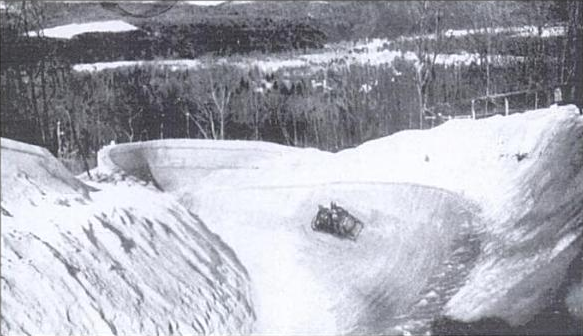A Yankee Notebook
NUMBER 2114
January 24, 2022
The Old Bobsled Run
EAST MONTPELIER, VT – A few days ago I sent a friend instructions about finding my house, and added, “About two-thirds up the driveway there are frozen ruts you should avoid. Left or right, doesn’t matter; just don’t get in ‘em.” I looked at those sentences, and heard a voice coming to me from 64 years ago, through a pair of ancient headphones. It was George Umber, the man watching Zig-Zag curve on the old bobsled run at Mount van Hoevenberg, near Lake Placid. “Bill,” he said, “tell Eddie Prue to tell the boys there’s a cut on the lower runner going into Zig.”
Now, George knew that Eddie could hear him – he had a headset, too – but he was pretty busy getting people ready to take rides down the run, and didn’t always listen. Plus, I think George wanted to get the responsibility for the news off his shoulders. If a sled runner went into a cut in the ice, especially at a tricky curve like Zig-Zag, things could get pretty lively pretty fast. If the “boys” – the bobsled drivers – were warned about it, they could decide whether to straddle it or try to go above or below it. Usually nobody else on the sled was the wiser. Usually.
Even given that one of the enduring joys of my life has been working with crews of men, the winters I spent at the bobrun rank right at the top. I’d been hired to work as a peon building and maintaining the run; but when it was operating, giving passenger rides or hosting races, I was the announcer, because, as the boss said, “You don’t have an Adirondack accent.” I was also responsible for the ancient public address system (think vacuum tubes) and the unbelievably cranky and easily distracted electric eye timers. Linked by my headphones to men all the way up the run to the mile start, I passed on to the visiting tourists a digest of everything that was going on up above and about to come thundering down past them. It was a great job, and the New York State pay grade for peons was almost three times what I could make ($1.35 an hour) anywhere else in the woods. But the greatest things about it, to my mind, were the crew and the technology.
There were a lot of old-timers on the crew – Art Yando, Otie King, Harold Parker, Spencer Branch, some of them survivors of the logging camps and full of stories. There also were full-time Conservation Department men, deployed to the run for the winter; a few young hotshots like me, often the butt of practical jokes; and last, the sweepings of the Saranac Lake unemployment office.
The bobsled run today is sleek, refrigerated, expensively shaded from the sun, and television-ready. In the late 1950s a lot of our technology came from the same source as the old-timers: the logging camps. The buildings were dark brown-stained fake log siding. We shoveled tons of snow by hand. We had a blacksmith who could build anything we needed, sharpen saw-toothed ice chisels to a razor edge, patch leaking hoses, or even tear down and rebuild a Ford 350 V-8 in a single day. He’d also built one of our most dreaded contraptions – the straightaway planer.
The artists on the crew – you could tell them by their shorter-handled shovels – plastered slush onto the dry stone-laid parabolic curves. The night crew, old guys who dressed and moved like troglodytes, sprayed the curves all night, somehow keeping their hoses from freezing. The peons (us), always under the supervision of more experienced men, sawed ice off a nearby pond and trucked it to the run, where we used it to build the walls of the straightaways. The sprayed surface of the straightaways was rough, and needed to be planed smooth. Which is where we shone.
Four men wearing creepers pulled the heavy planer; the fifth operated the blade. Two more followed behind to shovel the shavings out of the run. After each downhill pass, Howard, the blade operator said either, “Good” (to our silent cheers), or “Yeah, we gotta go back” (to silent groans). The Volga boatmen had nothing on us. To this day, I hear that theme when I recall that chore.
I loved working there. It was like being a kid again, playing in the snow with very big, very fast sleds – and getting paid well for it, too. But one day I looked around at my comrades, who didn’t seem to be quite as happy doing the same things I was. Then I noted they were mostly about twenty years older than I. It was time to move on. They were a wonderful three winters. But I can look back on them now with nostalgia mostly because I can look back from a distance.


